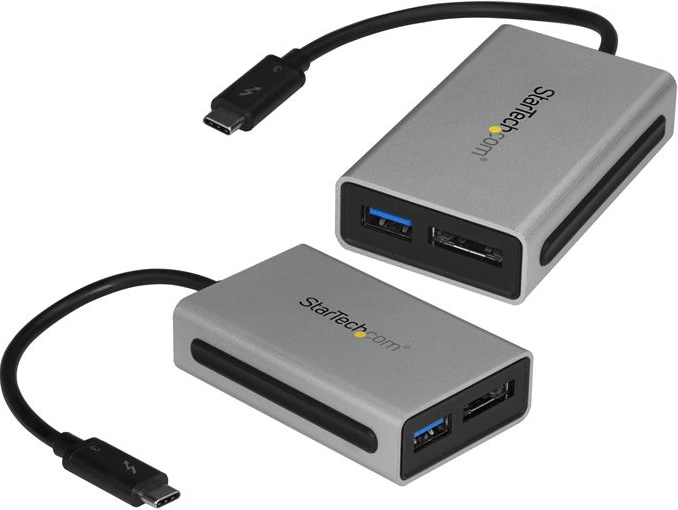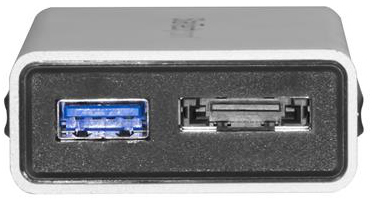StarTech’s New Adapter Brings eSATA Storage to Thunderbolt 3 PCs
by Anton Shilov on April 17, 2018 9:00 AM EST- Posted in
- Peripherals
- MacBook Pro
- eSATA
- Thunderbolt 3
- USB-C
- StarTech

Alternative headline: StarTech’s New Adapter Weds MacBook Pro and eSATA Storage
StarTech has expanded its lineup of Thunderbolt 3 adapters with a rather extravagant solution that features an eSATA port and a USB 3.1 Gen 2 connector. The dongle allows attaching previous-gen DASes to modern laptops, extending their life, and protecting their owner’s investments.
As the name suggests, Startech’s Thunderbolt 3 to eSATA and USB 3.1 Adapter (TB3ESATU31) has an eSATA port and a USB 3.1 Gen 2 Type-A connector. The eSATA header supports up to four eSATA drives through a port multiplier, allowing to use various external storage devices with new PCs. The dongle requires a standard TB3 port, meaning one that can supply up to 15 W of power and features bandwidth of at least 20 Gbps.
The Thunderbolt 3 to eSATA and USB 3.1 adapter is based on the Intel Alpine Ridge TB3 controller as well as the ASMedia ASM1061 PCIe-to-eSATA bridge. Judging by dimensions of the unit, its internal architecture is hardly very complex. The addition of the USB 3.1 port makes a lot of sense as it makes life easier for owners of products like the LaCie Rugged eSATA that use power from a nearby USB port. Meanwhile, owners of advanced eSATA DAS devices, such as storage arrays with multiple HDDs inside, will keep using their regular power bricks.
StarTech.com’s Thunderbolt 3 to eSATA and USB 3.1 dongle is available for $98.99 from Amazon and for $134.99 from StarTech.com, a price of an external hard drive (keep in mind that some of them are SMR-based and their performance is unpredictable at times). The MSRP may not be exactly a disadvantage of the product. The eSATA standard has never gained much traction outside of the market of professional-grade storage devices. Therefore, most of the eSATA storage that people would like to keep are likely professional-grade storage arrays. If someone is satisfied with performance of such an array and want to keep using it with their shiny new laptop (perhaps, not even for everyday work, but for archival purposes), they are unlikely to be concerned about the price of the Thunderbolt 3 to eSATA dongle.
Related Reading:
- StarTech's Thunderbolt 3 to Dual 4Kp60 Display Adapters Now Available
- Promise Launches TD-300 9-in-1 Thunderbolt 3 Dock: GbE, HDMI, USB 3.0, TB3 Charging & More
- OWC Launches 13-Port Thunderbolt 3 Dock: GbE, USB-A, SD Card, mDP, FireWire & More
- StarTech Unveils Dual-Display Thunderbolt 2 Docking Station with 12 Ports
- AKiTiO Displays Thunderbolt 3 to 10GBase-T Adapter
- CES 2017: GIGABYTE’s Thunderbolt 3 to 8x USB 3 Dock
Source: StarTech















22 Comments
View All Comments
HStewart - Tuesday, April 17, 2018 - link
Yes that is what I mean - this adapter is not necessary unless you have an existing eSata device that you want to connect to TB3. I had an enclosure that had eSata but never used - so it better to go for a USB-C enclosure and settle for 10GbsBut would be awesome now that TB3 is getting more popular and yes less expensive, is somebody come out with true TB3 enclosure with full speed for m2SSD's - such drives are available but for $500 or so ( usually Apple related )
repoman27 - Tuesday, April 17, 2018 - link
The only benefit I can see is that it gives you a PCIe connected SATA controller. So you can issue ATA commands like Secure Erase directly to the device.The PCIe 2.0 x1 back end of the ASM1061 would be the performance limiting factor here, potentially making it slower than some of the inexpensive USB 3.0 to eSATA adapters on the market.
ಬುಲ್ವಿಂಕಲ್ ಜೆ ಮೂಸ್ - Tuesday, April 17, 2018 - link
Most people will just pull the drive out of the eSATA case and use a USB 3.0 to SATA adapter (not eSATA)I have zero uses for eSATA on "modern" hardware, but maybe Peaches can enlighten us as to why this overpriced gadget is useful
Teach us Peaches!
repoman27 - Tuesday, April 17, 2018 - link
Yeah well, I’ve got a stack of SATA SSDs that I want to secure erase, but I don’t have a desktop rig handy. A USB adapter is no good to me in this situation. I also don’t feel like cracking open an iMac or any of my old laptops that still have SATA interfaces. So this adapter does have a niche, albeit a narrow one.And don’t be talking trash about the teaches of peaches... https://youtu.be/EpDmklLFXVc
ಬುಲ್ವಿಂಕಲ್ ಜೆ ಮೂಸ್ - Tuesday, April 17, 2018 - link
I have a couple of these USB to SATA adapters as well and they work fine for securely wiping SSD'shttps://www.newegg.com/Product/Product.aspx?Item=N...
Killdisk takes a bit longer than the SSD's secure erase function but they are wiped securely and that was the point, right?
repoman27 - Tuesday, April 17, 2018 - link
Um, no. The point is to securely erase the drive, restore performance (as much as is possible) to its original state, and do so without pointlessly writing to the drive and thereby reducing its useful life. Not only is Secure Erase much quicker, but in some cases it’s the only effective method. Try zeroing our an old drive with a SandForce controller, for instance.ಬುಲ್ವಿಂಕಲ್ ಜೆ ಮೂಸ್ - Wednesday, April 18, 2018 - link
Yes of courseKilldisk will securely erase the drive, restore performance (as much as is possible) to its original state, and do so without pointlessly reducing its useful life.
I have already used Killdisk over 300 times on a cheap $8 Silicon Power thumb drive using Toshiba Nand without destroying it and will finally give up trying after I hit 350 wipes sometime this summer
I have used Killdisk on every type of SSD and thumb drive I own without any problems
The media reports of destroying the Nand cells prematurely appear heavily exaggerated
Try it on a cheap worthless thumb drive if you doubt me
Fake news of wearing out your nand is easily debunked when you do your own testing
(Crap - double post)
galfert - Tuesday, April 17, 2018 - link
When will we see a USB-C to M.2 NVMe adapter? That is what I really want.ಬುಲ್ವಿಂಕಲ್ ಜೆ ಮೂಸ್ - Tuesday, April 17, 2018 - link
Try Google!Works for me
repoman27 - Tuesday, April 17, 2018 - link
Netstor makes a Thunderbolt 3 to dual M.2 NVMe device, but it’s pretty annoying that there isn’t anything in the way of a compact, bus-powered, PCIe 3.0 x4 NVMe external chassis available.Making one that works over USB instead of Thunderbolt would require an affordable, low-power, PCIe / NVMe to USB bridge chip. The soon to be released Titan Ridge Thunderbolt controllers allegedly provide some degree of bridging when connected to a conventional USB host, but we’ll have to wait and see how the actual implementation turns out.